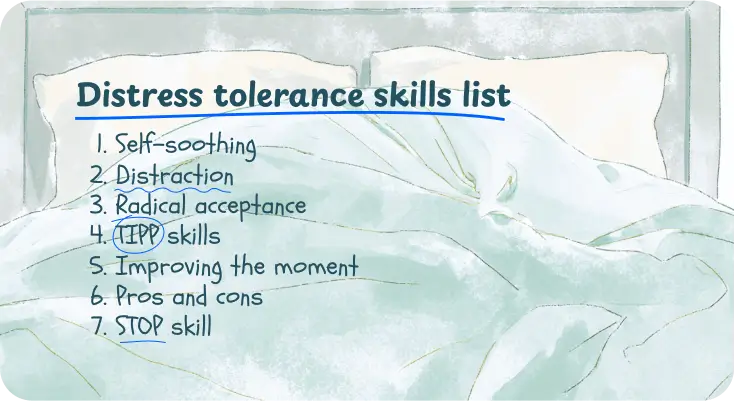Some of us might feel overwhelmed because of a minor inconvenience, like a change in plans. Others can remain calm even when moving to another country or changing jobs.
A big part of the difference in being able to handle stressful events comes down to distress tolerance. In this article, we’ll explain how distress tolerance skills help you handle various problems and highlight the ways to improve emotion regulation.
What is distress tolerance?
Scientists highlight that this term may have two slightly different meanings: (a) the perceived capacity to withstand negative emotional and/or other aversive states (e.g., physical discomfort) and (b) the behavioral act of withstanding distressing internal states elicited by some stressor. [1]
Let’s simplify and combine the definitions. Distress tolerance means someone’s ability to handle negative emotions and withstand them constructively without being impulsive or turning to unhealthy behaviors.
As such, people who have high distress tolerance can handle emotional pain and respond to it thoughtfully. If someone has high distress tolerance and, for instance, their wallet is stolen, they will calmly call a bank and go to the police station and not panic or freeze in the situation.
People with low distress tolerance might be more reactive and feel helpless. In the case of a stolen wallet, they can cry out, shut down, and avoid taking steps to solve the problem (which can make the situation even worse).
The theory behind distress tolerance
Let’s begin with some theoretical background to better understand the concept of distress tolerance and how scientists approach people’s abilities to manage distress. Here’s how this concept was introduced and the role it plays in today’s life.
Origins in dialectical behavior therapy (DBT) by Marsha Linehan
Marsha Linehan introduced and developed the concept of distress tolerance in her works in the late 1980s and early 1990s. She noticed that existing treatments didn’t work well for people overwhelmed by intense emotions.
The scientist tried to help chronically suicidal people and those with borderline personality disorder (BPD). Cognitive behavioral therapy wasn’t effective enough to help them manage emotional regulation issues. As such, Marsha Linehan applied her efforts to develop dialectical behavioral therapy.
Distress tolerance is now a key part of DBT. It helps people get through emotional crises without resorting to harmful behaviors. It involves skills that aren’t about fixing the problem right away. They’re about staying safe and getting through the tough moments without making things worse.
When DBT is helpful in the modern world
Dialectical behavior therapy originally served as a way of treating borderline personality disorder. [2] Yet, now, it can be helpful to a much broader number of people.
- DBT may be used while dealing with a range of mental health conditions, including anxiety disorders, depression, post-traumatic stress disorder (PTSD), eating disorders, substance use, and mood disorders.
- It can also serve to overcome strong emotions, impulsive behavior, or situations that feel emotionally unbearable, even if a person doesn’t have a specific diagnosis.

Why healthy distress tolerance skills matter
The ability to tolerate distressing situations and handle intense feelings can significantly influence your overall quality of life. [3] This is why it’s better to practice skills for managing worries in a healthy way.
1. They make it easier to overcome emotional crises and reflect in the most effective way
Whether you feel angry, ashamed, scared, or anxious, distress tolerance skills let you better handle moments of discomfort. You won’t shut down, get confused, or act out in ways you might regret later. Instead, you will be able to stay present, calm your body, and face emotional crises with more clarity.
2. They help you realize when you’re out of control
There might be situations when you can’t change anything, yet they get you out of balance. For instance, your partner has recently left you. You can’t force another person to stay together or change their mind. Instead, you can use distress tolerance skills to manage the emotional pain. This will be much better for your well-being than trying to escape or fix what’s out of your hands.
3. They help you deal with frustration in a healthy way
Sometimes you may not know what you want or need to do next. People with low frustration tolerance can get irritated, feel restless, and struggle to stay focused. They might give up quickly or avoid the problem completely.
In contrast, those who can handle uncomfortable emotions will be able to find balance, focus on things that matter to them right now, and search for the next small steps. These people don’t need answers right away; they can cope with uncertainty.
Do you think that you have good distress tolerance skills?
Symptoms of distress intolerance
Maybe you’ve started to wonder whether your distress tolerance skills are high enough. In this section, we provide the main signs that a person has problems with processing intense emotions. Check them out and reflect on your reactions.
1. Fear of distressing emotions
People with poor distress tolerance might feel uncomfortable when even thinking about potential stress or anger. They may be afraid to fear or feel worried when mentioning causes of anxiety.
2. Avoiding any potential stress
This point stems from the previous one. Those with low distress tolerance try not to leave their comfort zones and stay away from stressful situations. They aren’t typically the ones who like skydiving or bungee jumping.
3. The desire to escape when something goes wrong
If an emotional incident has already happened, such people may feel like they’re “frozen” or stuck. It’s tough for them to fix anything or look for ways out of the situation. They only desire the problem to disappear. Still, this pattern can lead to things getting even worse.
4. Catastrophic thinking
Using extreme phrases like “It’s impossible” or “I will never be able to do it,” paired with the inability to calm down and manage stress, is another symptom of intolerance. Such people believe that everything will definitely be bad and perceive small issues as major disasters.
5. Impulsive actions
When someone with low distress tolerance tries to fix the problem that causes stress, they may feel so overwhelmed and react without thinking it through. This means they might make quick decisions, say things they don’t mean, or do something risky.
6. Difficulty managing everyday tasks during emotional distress
People who face challenges with emotional regulation may find it difficult to do everyday chores when feeling overwhelmed. They can’t focus on work, stay relaxed when spending time with friends, or enjoy the evening with a loved one if a problem remains unsolved. Such people can’t simply get distracted and stay in the present moment; their minds become too focused on the reason for their worries.
Find out how often daily challenges make you experience intense emotional stress. Use Breeze’s mood tracker to spot when you feel overwhelmed and why this happens. Notice patterns and gain insights with clear and powerful analytics.
7. Maladaptive coping strategies
This term means behaviors that can bring short-term relief but, in the long run, may be harmful. They particularly include risky behaviors, self-harm, substance abuse, binge eating, social isolation, etc.
Scientists state that maladaptive coping styles correlate with increased psychological distress and higher risks of psychopathology, including anxiety and depressive symptoms. [4] As such, using these strategies can trap a person in a cycle where trying to feel better actually makes things worse.
Distress tolerance vs. coping strategies
While some people may confuse distress tolerance skills and coping strategies, they’re pretty different.
| Aspect | Distress tolerance | Coping strategies |
| Main goal | Help a person tolerate distress and control their actions in the moment | Help manage problems, daily worries, and challenging situations in the long run |
| Focus | Accepting the situation, not fixing it right away | Solving the problem or reducing stress over time |
| Timeframe | Short-term help for self-soothing | Long-term help as a way to manage emotional well-being |
| Dialectical behavior therapy (DBT) module | It is a part of the DBT approach | Can be used within many approaches |
Expert Insight
“Ideally, a person has both good distress tolerance and knows appropriate coping strategies. However, this isn’t always the case.
When someone has strong distress tolerance skills but lacks appropriate coping skills, they may be able to stay composed during a crisis or an emotionally charged incident, but they won’t know how to cope with their emotions in the long run.
This might look like being able to push through painful or stressful situations fairly calmly, but lacking the skills needed to cope with the resulting emotions. An example would be during an argument with a significant other, a person remains calm, but later they shut down and throw themselves into work.
If someone has good coping skills but doesn’t have strong distress tolerance, they may know how to cope with stress and have a good understanding of things like deep breathing and journaling. However, they won’t be able to utilize those skills during a crisis or when they are emotionally stressed. This is a pretty common issue, especially among those who have mental health issues like anxiety and depression.”
Emily Mendez
Mental health professional
Key distress tolerance techniques (with examples)
DBT distress tolerance skills are a set of strategies and approaches that allow people to handle difficult emotions and overcome crises without making them worse. Classic dialectical behavior therapy teaches these skills in a specific module, which is one of the four main modules in the DBT skills training manual alongside Mindfulness, Emotion Regulation, and Interpersonal Effectiveness.
Distress tolerance techniques are based on these skills and help people practice them in everyday life. Each technique is a simple, clear way to use a skill, like calming your body, accepting what’s happening, or stopping before you act. The more you practice distress tolerance skills, the better you get at handling difficult emotions.
1. Self-soothing (five senses exercise)
Using all five senses to relax and feel grounded can reduce anxiety symptoms and help handle negative emotions. This self-soothing technique involves focusing on something you can see, hear, touch, smell, and taste right now.
For instance, you’re at work and feel stressed before an important presentation. In this case, self-soothing can look like this:
- Sight. Look at the window, your workplace, or even at your own hands. Find 5 things you can see. Observe the textures, colors, and shapes.
- Touch. Find 4 things you can touch. It can be your table, shirt, hair, coffee cup, or some work papers. Notice their textures and how smooth they are.
- Hearing. Pay attention to the 3 sounds you hear. Maybe your colleagues are chatting, or the wind outside is too strong. Take some time to listen to them.
- Smell. Discover 2 things you can smell. This might be your perfume, hand cream, or even the scent of paper. Engage in mindful breathing and relax for a minute.
- Taste. Think about 1 thing you can taste. It can be a chewing gum, a protein bar, or even some water. Focus on the flavor.
Once you practice this self-soothing technique a few times, you’ll be able to use it almost anywhere. Five-senses exercise can give your mind a break from processing distressing situations and teach you to approach every situation more thoughtfully.
2. Distraction
Another important distress tolerance skill is shifting your attention from emotional pain to something more pleasant. For instance, when you’re waiting for the results of an important exam and feel frustrated but can’t influence the time they’re announced, this approach can be particularly helpful. You can always try the ACCEPTS technique:
- Activities. Move and do something engaging. You can go for a walk, do some cleaning, or visit a gym.
- Contributing. Do something helpful like write a supportive comment online, make coffee for a colleague, or order sweets for your loved ones.
- Comparisons. Remember the times of emotional distress when you felt worse than you do now. Think about the fact that you’ve managed to go through it and handle the challenges.
- Emotions. Find a source of positive emotions. It can be a quick catch-up with a friend, your favorite comedy show, etc.
- Pushing away. Try to forget about the situation for some time. Set a “deadline” by which you can stop ruminating on distressing emotions and looking for opportunities to fix the situation.
- Thoughts. Distract yourself and make your mind busy. You can start doing a challenging task at work, play a computer game, etc.
- Sensations. Focus on physical sensations: you can hold a warm cup, take a cold shower, or stretch your body.
The first few steps may help you feel much calmer and distract yourself. If not, keep going, as even a slight shift in focus can help you lower emotional arousal.
3. Radical acceptance
One of the core DBT coping skills is the ability to perceive the situation as it is. According to the study, practicing radical acceptance after thinking about a distressing event can help you regain balance and reduce the negative effects of worrying thoughts, even down to zero. [5] Here’s a simple yet effective distress tolerance technique that may let you calm down:
When you notice yourself experiencing intense emotional pain, it’s easy to fall into statements like “This shouldn’t have happened to me” or “I will never handle it.” Instead, try repeating some of the following and try to genuinely believe in your words:
- “I may not like it, but I can handle it.”
- “I can’t change the past, but I can choose how to move forward.”
- “Resisting it is ineffective; only acceptance can give me peace.”
- “I’m allowed to be upset and still move forward.”
4. TIPP skills
To reduce the symptoms of perceived emotional distress and focus on physical sensations, TIPP skills are widely used in dialectical behavior therapy (DBT). This is the most common way to apply this strategy:
- Temperature. Changing your body temperature can have a significant effect. Plash cold water on your face or take a cold shower to slow your heart rate and help you feel more in control.
- Intense exercise. Do something active for a few minutes, such as running, fast walking, or doing burpees. This will reduce adrenaline and improve emotional regulation.
- Paced breathing. Try breathing in for 4 counts and out for 6; this will help you calm down the nervous system and reduce anxiety. In fact, any type of deep breathing can lower resting blood pressure and reduce stress and anxiety. [6]
If you don’t want to do it alone, you can try relaxation games from Breeze. They suggest paced breathing with sound cues that help you stay focused even when your mind feels restless.
- Progressive muscle relaxation. Lie down on the floor or sit comfortably. Start from your feet: tense the muscles for about 5 seconds, then release and notice the difference. Continue with other muscle groups and go above. Engage in progressive muscle relaxation from legs to arms, shoulders, neck, and face. By the end, your body will feel more relaxed, and your mind calmer.

5. Improving the moment
This is another acronym that allows people to overcome emotional crises. Each letter in IMPROVE skills stands for a specific way to calm down your mind:
- Imaginary. Think about a safe place in your mind, like a quiet beach or cozy room, and imagine yourself there.
- Meaning. Try to find some meaning in the intense exercise you’re going through. Focus on the lessons you can learn.
- Prayer. Turn to your inner values and wisdom to find strength and overcome challenges.
- Relaxation. Take a moment to relax: listen to music, take a warm bath, or enjoy time alone.
- One thing at a time. Avoid ruminating on stressful thoughts and shift focus from emotional reactions to what you’re doing right now. Sometimes, fixing the problem step-by-step is the best idea.
- Vacation. Give yourself a short break. Even 5 minutes for your relaxation and improving self-awareness can help.
- Encouragement. During extreme emotional distress, you need to support yourself and use words of encouragement to handle the problems.
6. Pros and cons — quick and intense exercise
When practicing distress tolerance skills, it’s essential to remember that every reaction can have advantages and disadvantages. As such, it’s better to weigh whether to act on the urge or analyze the situation instead.
For instance, you want to quit a job because you feel too exhausted and bored by routine tasks. In this case, the pros and cons might be the following.
Acting on the urge (quitting immediately):
- Pros: instant relief from stress, opportunity to take a rest, no more boring tasks.
- Cons: lack of money, pressure to find a new job, and possible regret later.
Using initially developed distress tolerance skills:
- Pros: more time to plan the next steps, opportunity to change the situation in another way, keeping options open.
- Cons: you still have to deal with work-related stress, and change takes a bit more time.
Once you see a holistic picture, it’s easier to choose a strategy for action. You can also come up with unexpected ideas and completely change the plan.
7. STOP skill
This is another crisis survival skill that allows you to avoid acting without thinking, especially when emotions are too strong. The acronym STOP stands for the following:
- Stop. Pause for a moment, don’t do anything, and avoid impulsive decisions.
- Take a step back. Remove yourself mentally from the stressful situation and focus on what you feel inside.
- Observe. Concentrate on your physical senses. You can try paired muscle relaxation, self-soothing, etc. Then gently shift focus to your emotions.
- Process mindfully. Ask yourself, “What’s the smartest thing to do next?” and approach the situation accordingly.

How to practice and strengthen DBT distress tolerance skills
Once you know how radical acceptance and self-soothing positively influence your mental health, it’s time to practice the skills necessary to tolerate distress. Here are some tips that can be rather helpful:
- Start small and practice regularly. You don’t need to wait until an overwhelming situation to practice distress tolerance skills. Instead, it’s better to try different techniques once you feel worried about something less significant.
- Track what works for you. Maybe paced breathing won’t be super-effective for you, while radical acceptance will help you calm down quickly (and vice versa). Notice what’s more effective and apply these techniques over time.
- Connect certain skills to daily habits. For instance, you can take care of your mental health and improve distress tolerance skills when drinking morning coffee or before sleep.
- Practice mindfulness. Distress tolerance can work even better when paired with mindfulness. Use Breeze’s journaling features to understand what emotions you overcome when you feel worried and completely process your feelings.
- Don’t judge yourself when something goes wrong. Building distress tolerance skills can take time and some effort. Sometimes, you can feel overwhelmed, anxious, or even want to engage in maladaptive coping strategies (like self-harm or avoidance). Accept that mistakes happen and continue your journey.
Resources and tools to improve DBT skills
If you’re looking for additional ways to improve distress tolerance and handle stress more easily, we’ve collected some helpful resources. Try them now or save them for later when you need support the most.
The Breeze app
One of the most all-inclusive tools to build distress tolerance skills. The app allows you to keep track of your mental state, analyze what you’re feeling, collect stats about your emotions over time, and improve self-understanding with science-backed tests. Main features include:
- Mood tracker
- Mood analytics
- Journaling
- Self-discovery tests
- Relaxation games
- Customizable routines
- Social features (opportunity to share your results with friends)
DBT Diary Card & Skills Coach
This is another app that allows you to improve mental health and focus on feeling calm during stressful events. Created by a clinical psychologist with direct training under Marsha Linehan, it’s designed specifically for building distress tolerance skills and emotional regulation. Some of the important features include:
- A full library to learn DBT skills
- A skills coach
- Mood and behavior tracking
- Crisis support tools
DBT course
This course involves 40+ expert-guided lessons, videos, and practical worksheets that allow you to learn more about DBT. It guides you from mindfulness to distress tolerance, emotion regulation, and interpersonal effectiveness. The course helps you develop radical acceptance, learn more about your reaction to stress, and find inner balance.
DBT Skills Training Handouts & Worksheets by Linehan
Provided by Marsha Linehan, the creator of DBT, they’re a great resource if you want to understand and practice the skills step by step. The handouts explain every technique clearly and offer exercises to help you apply them in real life. You can write down your thoughts, track your progress, and come back to them when necessary.
We asked Emily Mendez, M.S., Ed.S., to suggest more resources to improve DBT skills. Here’s her recommendation. “The Dialectical Behavior Therapy Skills Workbook by Matthew McKay, Jeffrey C. Wood, and Jeffrey Brantley is a great resource. It is very helpful and user-friendly. DBT concepts are broken down into real-world scenarios and exercises. There are also reflection prompts to help reinforce learning. This is great for learning distress tolerance.”
Conclusion
You’ve discovered many new things about distress tolerance and its role in daily life. Now it’s time to practice! Download the Breeze app, check Marsha Linehan’s worksheets, and simply try approaching things with more calmness and resilience. After some time improving distress tolerance skills, you’ll see the real difference.
Sources
- Zvolensky MJ, Vujanovic AA, Bernstein A, Leyro T. “Distress Tolerance: Theory, Measurement, and Relations to Psychopathology.” Curr Dir Psychol Sci. 2010
- Robins, Clive & Rosenthal, M. (2012). “Dialectical Behavior Therapy.”
- Abd Ellatif Elsayed H, Aleriani F. “The relationship between distress tolerance and life satisfaction among young adults in Saudi Arabia.” Front Psychol. 2024
- Vidanagama, U & Godage, Sanjaya & Pn, Rodrigo & Fernando, C & Ekanayake, U & Hapuarachchi, T & Gunasena, P & Aluthge, P & Perera, Navoda & Gunathilake, S & Alvis, Kapila & Gunawardana, K & Rajapaksha, Sandya & Warnakulasooriya, A & Athulgama, P & Dius, Sanjeewa & Ranwala, R & Rathnayak, Band. (2024). “Maladaptive Coping Effects on Mental Health and Well-Being.”
- Segal, Or & Bronshtein, Karin & Weinbach, Noam. (2025). “The benefits of radical acceptance of reality as a standalone strategy for emotion regulation.” Current Psychology
- Tavoian D, Craighead DH. “Deep breathing exercise at work: Potential applications and impact.” Front Physiol. 2023
Disclaimer
This article is for general informative and self-discovery purposes only. It should not replace expert guidance from professionals.
Any action you take in response to the information in this article, whether directly or indirectly, is solely your responsibility and is done at your own risk. Breeze content team and its mental health experts disclaim any liability, loss, or risk, personal, professional, or otherwise, which may result from the use and/or application of any content.
Always consult your doctor or other certified health practitioner with any medical questions or concerns
Breeze articles exclusively cite trusted sources, such as academic research institutions and medical associations, including research and studies from PubMed, ResearchGate, or similar databases. Examine our subject-matter editors and editorial process to see how we verify facts and maintain the accuracy, reliability, and trustworthiness of our material.
Was this article helpful?







